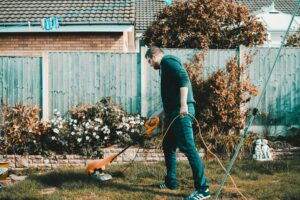
“Weed Eating is Killing My Lower Back”
and Other Problems that Spring Brings
By: Andy Tatom, PT, DPT, OCS
It’s that time of year again. Spring. The birds are singing, the trees are budding, and the flowers are blooming. What goes along with all that warm weather and vegetation? Weeds. From pulling weeds out of the ground by hand to edging with an electric or gas weed eater, getting rid of unwanted growth is an essential part of lawn maintenance. Yet, this daunting task often causes back pain that lasts longer than a season. How can you avoid hurting yourself and still get the job done? Here are some tips I like to share with my back patients:
Chose the Right Machine
Are you working along a fence-line away from the house where a gas trimmer is needed? If so, make sure the machine has an optional shoulder strap. Also, you want to try to pick a machine that is as light as possible. Electric trimmers that you can use closer to the house are often lighter than gas trimmers. If possible, buy two weed eaters to use in the appropriate places so you’re not always having to use the heaviest machine.
Stretch

Following Dr. Tatom’s simple advice can help you enjoy your outdoor activities this spring and avoid low back pain.

Gardening can cause low back pain if you’re not careful. Follow Dr. Tatom’s simple advice for a pain-free spring.
It’s very important to stretch before you begin your yardwork. Extend your arms over your head and feel the stretch in your upper torso and shoulders. Hold for 10 seconds and repeat eight times. Also, place your hand above the back of your elbow across your chest toward the opposite shoulder. Stretch both the right and left arms. Hold for 10 seconds and repeat eight times. Lean down and touch your toes. Hold the stretch for 10 seconds and repeat eight times. Stretching is a must-do before you start with weed eating or any gardening activity.
Do Not Twist Your Lower Back
Always keep your shoulders in line with your hips and twist your whole body by moving your feet, not your lower back. Lower back pain is common and chores such as weed eating often exacerbate pain. Resist the urge to twist and you’ll go a long way to helping your back stay healthy.
Take Breaks
You don’t have to do the whole job at once! Divide the job into sections and take rest breaks at the end of each section. Stretch during a break or hydrate with a glass of water. There’s no shame in taking a break every now and then. Your back will thank you!
Beware of the Terrain
Be careful on hills. It’s more difficult to keep from twisting because you can’t move your feet as easily. Slow down and walk around what you are trimming. Be sure to wear quality shoes with good traction because you don’t want to slip. Resist the urge to wear old, worn-out shoes for your yardwork. Wear good shoes to avoid injury.
Other Good Tips for Gardeners
Change positions often to avoid stiffness. Always use a garden cart or wheelbarrow to move heavy objects. Maintain good posture. Be kind to your knees by using knee pads or a gardening pad. If leaning down to care for your garden gives you a lot of back pain or knee pain, consider using elevated planters for your garden. Keep moving when you finish by taking a short walk or doing light stretching.
Persistent Problems?
If you’re unable to manage aches and pains or if your discomfort continues, please come see us at Rehab Associates. With hands-on care and patient education, we’ll do all we can to help you keep your weeds at bay. We’ll provide a complete evaluation and a detailed treatment plan that will help you stay healthy and injury-free while you maintain a pristine lawn free of pesky weeds.
If you need additional information about low back pain, follow this link https://racva.com/back-pain/.
For evidenced-based therapy that can help you reduce back pain and enjoy lawncare, gardening, and other warm-weather activities, give us a call today at 855-722-8478. I see patients in our Clifton clinic and would love the opportunity to help you make the most of your spring!
